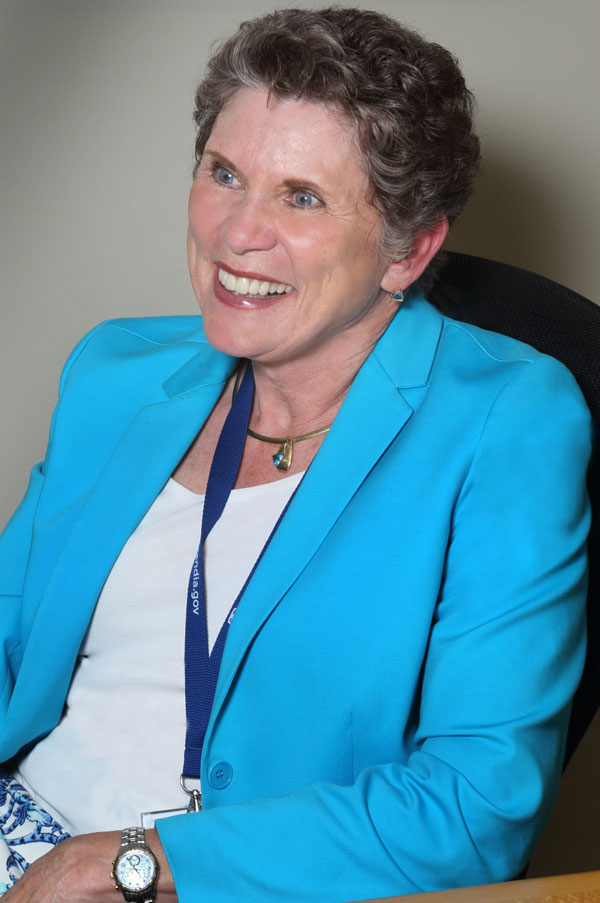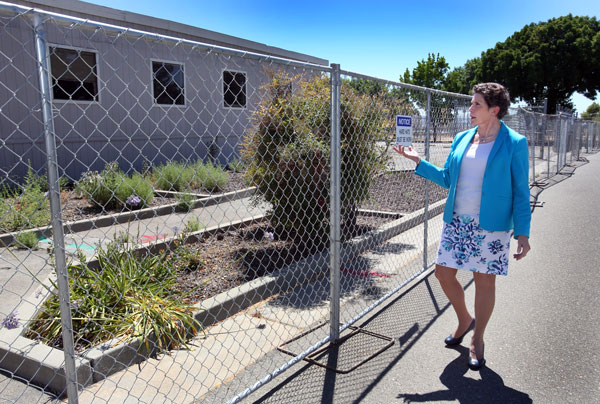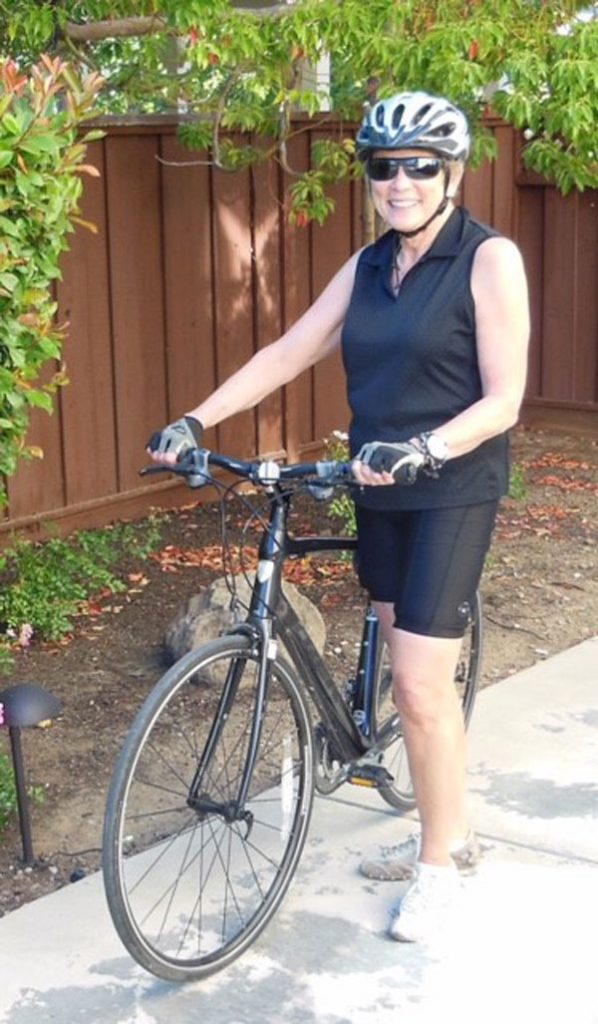See below: "ALD’s amusements"
Lab News team member Jules Bernstein recently caught up with Associate Labs Director Dori Ellis to get her thoughts on where Division 8000 has been in the last year and where it’s going. She reflects on the first year of NTESS management, expected growth at the California site, and aspects of Sandia culture she’d like to preserve during these times of change.
A peek at the past
Jules Bernstein: Sandia recently celebrated the one-year anniversary of the Labs’ transition to NTESS management on May 1, 2017. What stands out for you looking back at the first year?
Dori Ellis: One of the big achievements has been preparing to get ramped up on the W80-4. We’ve put a lot of energy into finding the right space, hiring people — we’ve hired over 300 this year — and making sure we have the right configuration and the right people to get moving. We’ve got a substantial uplift coming.

JB: Sandia/California has had some key visits this past year including DOE Secretary Rick Perry and NNSA Administrator Lisa Gordon-Hagerty. What is the key message you want to leave with visitors like these?
DE: There are at least a couple of takeaways. One has to do with the unique functions and capabilities that are located in California, and our relationships to Lawrence Livermore National Laboratory and to the technology industry here in the Bay Area. We really do have a unique position relative to some of the other labs, even as compared to our New Mexico lab. It’s much easier for us to connect with these groups in the neighborhood.
The other takeaway is that we take our work very seriously, we take our relationship with our New Mexico counterparts very seriously, we really do want to project and be one laboratory.
The ‘one laboratory’ emphasis is partly so we can more seamlessly deliver on our mission and on services. It also means that we are using the same policies and practices to the extent that we can around security and safety, how we work and how we hire.
We’ve had challenges around differences in the way we provide physical security. In New Mexico they have a guard force of full-time, regular Sandians and here we have a contract workforce. The security organizations in both places are working very closely together, along with our counterparts at Lawrence Livermore, because we share some services with them.
JB: What aspects of Sandia culture do you feel are especially important to preserve as we move into the future?
DE: Sandia has a very strong culture of ‘get ‘er done.’ It’s important we don’t lose that. As an engineering laboratory we have capabilities that we can bring to bear not just on the weighty problems of nuclear security and deterrence, but also in applied engineering for energy programs and many of our other areas. We really have a foundation here that’s different than many of our laboratory counterparts.
The other aspect of the character here is generosity of sharing across technical areas. People are willing to be part of a team as opposed to being an individual doing their own thing, which means Sandia can take on very large, complex programs that we couldn’t otherwise execute.
Sandia rewards teamwork. There’s still competition of course. We all got here by being competitive. But ultimately people are able to subordinate their own personal outcome if needed so that the laboratory has a better outcome overall.
JB: Are there aspects of Sandia culture that you feel we should work to leave behind?
DE: There has been something of a cultural divide between our mission delivery organizations and our mission enabling organizations. We are trying to bring those two sides of the organization together seamlessly so that we not only deliver a superior engineering product, but we deliver it in the most efficient, effective way possible. It’s giving respect to the professionalism of our enabling services and focus on bringing their best work to bear on our problems.
Reflections on the present
JB: Some programs have seen cuts in funding, and with budget cuts often comes changes in morale. What advice do you give to those impacted by these cuts?
DE: The cuts that we’re seeing are much smaller than we expected. Even though this administration made some very strong statements about intent with the President’s budget, the truth is Congress express their priorities. We’re seeing very little happening to overall budget sizes. Some of the priorities are changing in some areas, however. Next year as a laboratory we’re once again expecting to see substantial increases. Our big challenge is going to be finding the right people and adequate space to be able to execute on the money coming in.
JB: Can you share an example of a time in your career where you successfully navigated morale challenges? What was your strategy?
DE: Every program has a beginning and an end. It’s not unusual for people who’ve devoted a lot of time and energy to a program to be disappointed when there are changes. The main thing is to make sure you’re working with your manager and senior manager on what’s coming next because heaven only knows we’ve got a lot of work coming. If you can be a little flexible around what you want to do, there’s plenty of work.
JB: We have heard a lot about the increased volume of work headed our way as a result of the Nuclear Posture Review. Do you have advice for navigating work/life balance in times of high workload?
DE: Work/life balance may be a bit of a misnomer. It’s more like a teeter-totter. We do try very hard to make sure people have a meaningful work experience and then have time to go home and spend time with their family or friends, or however they like to spend their free time. But there will be times when we’re called upon to do more, and we appreciate that people are willing to do that, recognizing that it does come at a cost.
We’re trying to do things like the 4/10 schedule. We’re hopeful that we can extend the 4/10 to our nonexempt staff soon. We are waiting on some changes to the time reporting system to meet current regulations. I’m very eager to see how that works. Here in California, our folks may be experiencing a very long commute. Being able to come to work one day less a week can eliminate four hours of frustration.

JB: What’s happening to the Redwood Center mobile buildings at Sandia/California?
DE: We’re tearing it down. It’s very old, and isn’t the kind of space we’d like to have our employees living in. The intention here is to get it gone and put the emphasis not on maintaining old buildings, but rather on improving the space that has a lifetime that’s a little longer. We’re not going to build new office space yet. There are things we’d like to do to the site, and we’ve got them included in the budgets going forward. Next year we should see updates to building 928 and a new data center to replace the system we’ve had for so
long. We also hope to put another roughly 50 people in an updated mobile 50 by the end of this fiscal year.
Gazing into the future
JB: We have seen a lot of opportunities for Division 8000 members to work together. Any new projects coming up that you’d like to see more interaction from across the division?
DE: We have brought energy and homeland security together, which gives us an opportunity to work on things like resilient energy systems and civilian cyber projects. Those are projects that are going to be not just across our division, but across the laboratory. Those cross-organizational, cross-functional teams really can do much more than individual organizations. We’re looking forward to that kind of work.
We also support all of the other mission portfolios. Of course, Nuclear Deterrence support is a huge part of the work that we do here. But we also support the Defense Nuclear Nonproliferation, National Security Programs, and Advanced Science and Technology.
JB: We have seen a lot of growth around Division 8000, what can we expect for the upcoming year? What are some of the challenges we’ve experienced around this growth, and how do you recommend we deal with these challenges going forward?
DE: There are at least two challenges: space and people. We’re having to move people around, probably more intentionally than we have before. We’ve gone back to collaborative space with many people and low partitions as opposed to hard offices. The hiring in California and in our 8800 New Mexico center are really challenging for a couple of different reasons. In the science areas, large numbers of the graduate students we have access to as postdocs are foreign nationals, which is more challenging for us to handle.
With sciences, engineering, and even some mission enabling functions there’s also the hyper competitive nature of opportunities and salaries in the Bay Area. We’ve lost people to three times or more their salary. While we’ve won awards nationally for quality of life, when you look at a factor of three on your salary it’s a little hard to say no, at least short term.
One of the things we are seeing are people who have gone to some of these startups or a Google or Facebook, working very long hours there with a long commute, and maybe putting together enough money for a down payment on a house or other objective. Then, some of them are coming back because of the quality of the mission, the quality of the people you get to work with, and the work/life balance.
ALD’s amusements
It’s not all work all the time for our Associate Labs Director – it is summer after all. Here, Dori shares some of her thoughts for the off hours.
JB: What are your top books for summer reading?
DE: One of the books I’d recommend from a diversity and inclusion perspective is Turtles All The Way Down. It’s a look at a young woman who has some mental health issues, and it lets you inside her head. Her reality is very different from the reality of those around her. All of us have our own reality, regardless of what our mental health status is. And sometimes it’s easier to give people the grace, the benefit of the doubt, and try to understand what their reality looks like. While I wouldn’t call it light reading, I would strongly encourage it.
I went to the White Men and Allies session last week and it had such a profound impact on me. Some of our people of color talked about the challenges of being in an environment where just by virtue of their skin color or how they look, they feel fearful. One of them said they were going to buy a gun for their home. What a tragedy that the dialogue has descended so far into discord.

One of the things we have to do here inside the lab boundaries is make sure we’re talking about values, tolerance, respect and integrity. We can’t do anything about the political climate, nor should we take a political stand as a Laboratory, but inside the Laboratories we can take a much stronger stand on behaviors. I can’t force you to think one way or another. But if you’re going to work here, I can ask you to behave in a professional way.
One of the takeaways from the session is how much overlap many of us have in ways we didn’t realize. For example, many people in that group came from very humble beginnings. And many others grew up in a family in which mental health issues, alcohol or drug abuse were a part of their life. Still many others once lived in a neighborhood that was all segregated. So many of us that might seem different do have a lot of shared experiences.
Another book I recommend is the recently released one by James Patterson and Bill Clinton, The President is Missing: A Novel, about the challenges faced by a president. Of course, it’s a murder mystery and action packed. But it also looks at the responsibilities that come with being a national leader that may come at a personal price. The same is true whether you’re the leader of a department, group, center or division. It’s not always easy.
JB: What TV shows, if any, could you recommend as worthy of binge watching?
DE: We’ve been watching a series called Reverie. It’s a story of a computer program which lets you take a virtual trip into a world of your own creation, and the blessings and problems associated with that. It’s very interesting premise. For people struggling, the temptation is to go into their reverie and stay there. The premise of the show is that it’s a very unhealthy thing to do.
JB: Is it better to be lucky or smart?
DE: If you’re really lucky, you’d have been born smart.